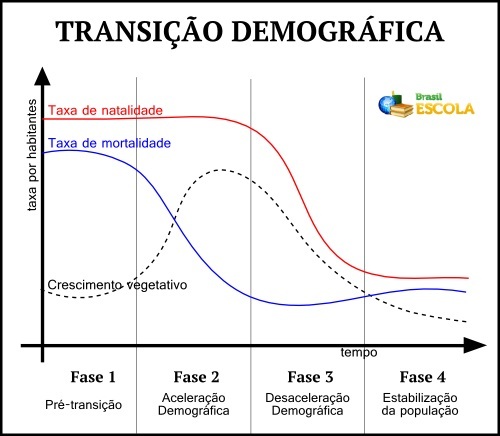THE demographic transition is a social premise elaborated by the American demographer Frank Notestein, in the first half of the 20th century, to refute, through numbers and data, the population theory malthusian, which stated that population growth was occurring at an exponential rate. In the design of the demographic transition, it appears that, in fact, there is a trend in which populations from different places grow as cycles that intensify and then reduce under the most diverse reasons.
The demographic transition theory states that there is no single, constant process of population explosion or very high population growth. When this phenomenon occurs, it is postulated that the tendency on the part of the various places is that there is a further stabilization, especially due to successive changes in the birth and death rates. The main effect of the demographic transition, in this sense, would be the process of population-ageing.
According to leading theorists of population theory in question, the demographic transition can be segmented into four different phases.
1st phase - Pre-transition
The first phase of the demographic transition, also called pre-transition, occurs when there is a certain balance between birth and death rates, but both with very high values. In these cases, they are societies that have low economic and social development, where many people are born annually and, at the same time, many lives are lost due to epidemics, low life expectancy and precarious conditions Sanitary. A scenario like this could be seen in Europe in the initial phase of its industrialization.
2nd phase – Acceleration or population explosion
In the second phase, what many call the population explosion, the sharp population growth in a short period of time. But the demographic transition theory demonstrates that this process does not occur by increasing birth rates, but by sudden decrease in mortality rates, due to social improvements in terms of health, sanitation, access to water and others factors.
This process took place in Europe throughout the nineteenth century, in most emerging countries throughout the twentieth century (including Brazil) and currently takes place in peripheral countries, with emphasis on Nigeria and other nations in development. The European continent also witnessed a sharp demographic explosion in the post-war period, which generated the expression “generation baby boom”.
Do not stop now... There's more after the advertising ;)
3rd phase - Demographic slowdown
As societies develop, the general trend is for a reduction in birth rates, which is explained by the spread of planning. family, the inclusion of women in the labor market, intensive urbanization (in the countryside, fertility rates are always higher), among others factors. For this reason, there is a gradual process of decline in the number of births, which happens at a slower rate than the drop in mortality.
This process began to be experienced in Brazil in the second half of the 20th century, especially from the 1970s onwards. Currently, birth rates in Brazil are very low, almost always below 1% per year.
4th stage - Demographic stabilization
Demographic stability is achieved when birth and death rates finally drop. balance, maintaining levels that, although they may show fluctuations, remain at averages very low. In this scenario, it is said that there is complete control of population growth.
Look at the chart below:

Schematic graph of the cyclical processes of the demographic transition
Given this panorama, it is noted that population growth is contained, which represents, in a way, an advantage. On the other hand, when this happens, there is also the process of population-ageing, as the high life expectancy and low birth rate generate an average increase in the age of the population, which provides the fall of the economically active population and the growing possibility of an economic and Social.
In many European countries, the reality of population aging knocks at the door, as the average number of children per couple is less than two and the number of elderly people is increasing. Many countries – such as France and Germany – carry out various campaigns and even provide financial incentives for couples who want to have a second or third child. Brazil is also threatened by this problem, so that we are no longer considered a “young country” to become an “adult country”.
By Me. Rodolfo Alves Pena


